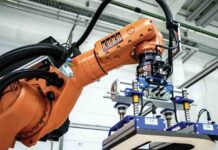
Keeping in view the current global scenario, recently, Pascal Brier, Chief Innovation Officer at Capgemini and Member of the Group Executive Committee, said, “It is impossible to deny the transformative impact of technology. Generative AI is an obvious example, but it is not the only one.” He also added that every day, Capgemini’s teams are scanning the
technology landscape to harness the power of innovation for their clients and anticipate key
technology breakthroughs on the horizon. Besides generative AI, areas to watch in 2024 include evolutions in semiconductors, post-quantum cryptography, battery technologies, and new space exploration, all of which will be instrumental to help them address the challenges of our economies, communities and ecosystems.
Generative AI: Small will be the new big
Generative AI has made a crashing entrance in the global technology and business conversation Electrical India | January 2024 55 in late 2022 and 2023, with expectations of significant business impact. In 2024, will it live up to the massive amount of hype it has generated? The short answer is yes. While current ‘Large Language Models’, will continue to
thrive, there is also an increasing need for smaller, more cost-efficient models. These models will get smaller and smaller to run on low-footprint installations with limited processing capabilities, including on the edge or on smaller enterprise architectures.
In 2024, new AI platforms will also increasingly battle hallucinations by combining generative AI models with high quality information from Knowledge Graphs. A knowledge graph is a structured representation of data and how they are interconnected. In support of all this, platforms will arise, providing tools for companies to leverage generative AI without the need for deep internal technical expertise. This will lead, in the long run, to the creation of interconnected networks of models designed and fine-tuned for specific tasks, and to develop true multi-agent generative ecosystems.
Why it matters: These developments in generative AI are indicating an evolution towards a more accessible, versatile and cost-effective technology. These innovations will enable organizations to scale their generative AI use cases faster while also deriving more long-term value from the technology.
Quantum technologies: When cyber meets quantum
A cyber arms race is under way, where advancements in computing power must be met by bolstered digital defence mechanisms. For example, AI and Machine Learning (ML) are increasingly being used in threat detection, while the zero-trust security model may become a global standard. But a new threat is rapidly emerging, driven by the development of quantum computing, which may render obsolete the current encryption standards like
RSA and ECC.
The development of quantum-resistant algorithms is therefore becoming a pressing necessity for maintaining data privacy and security in the future. In the US, thestandard for ‘Post-Quantum Cryptography’ (PQC) i.e., encryption algorithms believed to be resistant to quantum attacks, will be issued in 2024 by the National Institute of Standards and Technology (https://bit.ly/3vv71Bl).
As the Quantum Computing Cybersecurity Preparedness Act requires public and private organizations supplying the US government to be ready to migrate to PQC within a year
after the NIST standards are released, this topic is bound to make its way into board room conversations in 2024.
Why it matters: This emerging shift promises to upend the very basis of cybersecurity standards globally. All business leaders and technology experts will be affected by this approaching milestone, while more and more organizations begin their quantum transition.
Semiconductors: Moore’s Law isn’t dead, but it is changing
As the most traded good in the world ahead of crude oil and motor vehicles (https://bit.ly/4aRmfkd), semiconductors are a crucial enabler of digital transformation. Moore’s Law states that the computing power of a microchip doubles every two years while the cost halves – but is this theory reaching its physical and economic limits?
The semiconductor industry is on the verge of a transformative era, with multiple factors converging to redefine its landscape in 2024. Chips are reaching 2nm, transistors are approaching the size of a few atoms, and the ever-growing investments in R&D and cutting-edge fabrication facilities are becoming challenging for even the largest chipmakers.
2024 should see an evolution of Moore’s law, with new paradigms: despite approaching the absolute physical limit of chip miniaturization, chiplets (sub-elements of a chip that are split into functional blocks) should see breakthroughs in 3D chip stacking, innovations in material science and new forms of lithography to continue increasing computing power.
Why it matters: An accelerated digital transformation is expected across industries, enabled by more powerful connected objects, from smartphones to electric vehicles, to data centers and telecoms. These technological breakthroughs will be reflected in shifts
in the ecosystem of semiconductors itself, with new gigafactories, regulations, business models and foundry services emerging in 2024.
Batteries: The power of new chemistry
Improving the performance and reducing the costs of batteries is a major focus for both businesses and governments, as the industrial stakes are high for each nation. The aim is to support electric mobility and accelerate long-duration energy storage, which is critical to speed-up the energy transition to renewables and the acceleration of smart grids. While LFP (Lithium Ferro-Phosphate) and NMC (Nickel Manganese Cobalt) are becoming standard for electric vehicle applications, several technologies with the chemistry of batteries are being explored, such as cobalt-free (sodium-ion) or solid-state batteries, with a likely acceleration in 2024.
The latter represents a major shift in battery technology, primarily for electric vehicles, as they have higher energy densities (i.e., storage capacity), for a price which will become lower than traditional batteries. They also reduce dependency on materials such as particular lithium, nickel, cobalt, rare-earth minerals and graphite, while promising longer lifespans and more robust safety.
Why it matters: In a business world driven by the energy transition and the fight against climate change, these emerging developments may offer a pathway towards greater choices for the battery industry and a more sustainable use of materials.
Space tech: Addressing the earth’s challenges from outer space
In 2024, humanity will be preparing to return to the moon. This renewed interest in space technologies aims to drive scientific discoveries and help solve the earth’s most critical challenges, including the monitoring of climate risks and disasters, better access to telecommunications, as well as defence and sovereignty.
The New Space Age is driven not just by government agencies, but also by private actors, from startups to corporations, and is supported by various technologies such as 5G, advanced satellite systems, big data, quantum computing, etc. In 2024, this should accelerate innovation and support very promising technology projects in the field of sustainable spacecraft propulsion (either electric or nuclear) and new Low Earth Orbit constellations for seamless communications and quantum cryptography.
Why it matters: The last Space Race revolutionized the world by accelerating groundbreaking innovations like satellite technology, GPS, integrated circuits, solar
energy and composite materials. This return to the stars promises similar revolutions in the fields of computing, telecommunications, and earth observation.



















